

 |
 |
A canopy that leaks is not nearly as comfortable or effective as one that keeps the weather out. Two issues arise here, how effective is the closure system on the canopy openings and how easy are they to use. All the closure systems are a compromise, but overall we prefer ease of use that doesn't require much manual manipulation. Digital dexterity is one of the first things lost as a result of exposure, driving our point of view.
Zippered closures, at least those with large zippers and handy zipper pulls, such as Winslow's and BFG's, are the easiest to use and fastest canopies to close up. Closures using cloth ties, such as EAM's, can be very difficult to use in cold weather. Tie closures and snap closures (as used by Hoover) systems are inevitably less waterproof than a well designed zippered system with good storm flaps. Velcro can help improve weathertightness, but when it's the sole closure, such as on SPI's canopies, it is not very effective.
To test the canopies we made use of a fire hose and adjustable nozzle. Before the test each raft was closed up as well as we could. Each raft was rained upon from about a 35-40 degree elevation as our stoic volunteers rotated the rafts around in the cold water stream while the hose-man drenched all portions of the raft and canopy. Our marine testers agreed that it was a reasonable approximation of a moderate storm at sea. Testers inside noted leaks or other problems. Serious leaks were immediately evident from the screams of the volunteers as cold water came in.
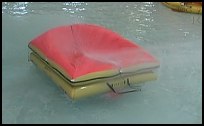 The Survival Products canopies immediately collapsed in our storm and let copious amounts of water in under the bottom edge of the canopy and through the Velcro'd "door" slit. Volunteers complained about the chill transferred through the canopy to their bodies because they were unable to avoid contact with the collapsed canopy. Even in a light shower it would be difficult to avoid contact with the cold sides do the the canopy design.
The Survival Products canopies immediately collapsed in our storm and let copious amounts of water in under the bottom edge of the canopy and through the Velcro'd "door" slit. Volunteers complained about the chill transferred through the canopy to their bodies because they were unable to avoid contact with the collapsed canopy. Even in a light shower it would be difficult to avoid contact with the cold sides do the the canopy design.
The Navigator canopy (not tested with a fire hose) was more waterproof, due to the sealed bottom edges, though it still leaked plenty of water through the Velcro vertical flap seal. The angle of the canopy material presented similar problems to the SPI.
Both Hoover and EAM rafts leaked badly in the same areas. The flap entries were impossible to seal completely and let in lots of water through the gaps. The EAM flaps blew open despite its cloth ties, Hoover's snaps did better except under direct impact by the water stream. At best these would also allow in plenty of cold air in windy conditions. Both canopies came undone at the bottom as the elastic skirt slide from over the buoyancy tube, letting in lots of water. The rods and canopy material itself did quite well under the onslaught.
Both leaked badly where the water collection tube was sewed into the canopy roof. There was also some leakage at the sewn seams. Aside from the leaks, the water collection tube worked reasonably well, though the only way to close it off was to tie a knot in it.
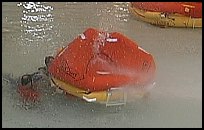 Because of the damage to the Air Cruisers entry zippers, it was impossible to test the weathertightness of the 13-person raft. In later testing, the water collection devices worked very well. The 4-peron, which still had functioning zippers at the time of the weather tests, leaked relatively little through the zippers, but the canopy collapsed completely even under a partial stream of water. That's not good and is cause for concern. Of course, once the zipper failed, so did the 4-person's rating in the weather test.
Because of the damage to the Air Cruisers entry zippers, it was impossible to test the weathertightness of the 13-person raft. In later testing, the water collection devices worked very well. The 4-peron, which still had functioning zippers at the time of the weather tests, leaked relatively little through the zippers, but the canopy collapsed completely even under a partial stream of water. That's not good and is cause for concern. Of course, once the zipper failed, so did the 4-person's rating in the weather test.
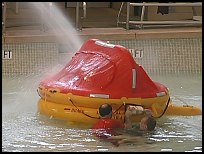 The new BFGoodrich rafts are reasonably weathertight, though they leaked some water through the zippers due to the lack of good storm flaps. The canopy on the 12-person raft sagged considerably once it got wet, significantly reducing headroom through much of the raft. More of a concern, the 12-person canopy seems to have a weak spot on top where the center support joins the support hoop. We saw some minor collapse of that section, but it didn't collapse completely and rebounded immediately.
The new BFGoodrich rafts are reasonably weathertight, though they leaked some water through the zippers due to the lack of good storm flaps. The canopy on the 12-person raft sagged considerably once it got wet, significantly reducing headroom through much of the raft. More of a concern, the 12-person canopy seems to have a weak spot on top where the center support joins the support hoop. We saw some minor collapse of that section, but it didn't collapse completely and rebounded immediately.
The old BFGoodrich 4 person let in plenty of water through the zipper which had no weather flap. It did appear it would effectively seal out wind fairly well.
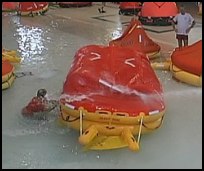 The old BFGoodrich 7 person let in very large quantities of water
through the top of the doors. The sides are gussetted which is an
excellent design, but there is no provision at all for sealing the
top. The large gap at top let in water and would have resulted in
a very drafty interior, especially so due to having an opening at
each end and the shape of the raft insuring the entries would be
facing directly into the wind. In any kind of windy weather,
pretty common in the marine environment, this pretty much defeats
the gains that might be expected from the double walled canopy.
The old BFGoodrich 7 person let in very large quantities of water
through the top of the doors. The sides are gussetted which is an
excellent design, but there is no provision at all for sealing the
top. The large gap at top let in water and would have resulted in
a very drafty interior, especially so due to having an opening at
each end and the shape of the raft insuring the entries would be
facing directly into the wind. In any kind of windy weather,
pretty common in the marine environment, this pretty much defeats
the gains that might be expected from the double walled canopy.
The water collection system worked very well. We have heard reports of the tubes coming adrift and letting water inundate the raft, but despite some pretty forceful tugging, they didn't budge and seemed secure.
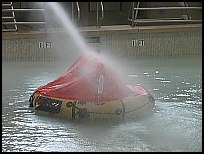 The Winslow rafts proved exceptionally weather resistant. All the zippered
seams have an excellent Velcro'd weather flap which helped reduce water coming
through the zippers to next to nothing. The view ports in the Island Flyer dribbled minor amounts of water through the sewn seams. The heavier canopy material of the Ultima and Island Flyer stood up to the force of the water better with less sagging than the lighter material of the Ultra-Light.
The Winslow rafts proved exceptionally weather resistant. All the zippered
seams have an excellent Velcro'd weather flap which helped reduce water coming
through the zippers to next to nothing. The view ports in the Island Flyer dribbled minor amounts of water through the sewn seams. The heavier canopy material of the Ultima and Island Flyer stood up to the force of the water better with less sagging than the lighter material of the Ultra-Light.
The combination observation port and water collection tube worked, but it isn't a great water gatherer. To use it you pull it into the raft and use an integrated nylon tie string to neck it down to put water into a container. It also only drains from a small portion of the canopy. Since a watermaker is standard on the TSO'd rafts, we don't consider this a serious problem.
The TSO (TSO C70a 4.4) requires "means must be provided to make the openings weathertight." Obviously, with regard to weathertightness, there is apparently quite some latitude allowed for interpreting the meaning of that word as evidenced by most of the rafts' poor performance in this regard.
From the perspective of comfort, a canopy cannot be too roomy or too dry. While excess space is not a good idea in cold weather, too little headroom is a pain, literally. The larger rafts all do a pretty good job, the BFGoodrich canopy is probably the best from a headroom perspective. When the canopy collapses or fails to one degree or another, as did the Air Cruisers and Survival Products among others, then all bets are off, you are going to be miserable and in many situations your survival may be in jeopardy. With the single arch canopies, cold transfer problems are inevitable except under the arch itself, but at least the Winslow, and to a slightly lesser extent the BFGoodrich, will keep you reasonably dry..
Winslow's Ultra-Light suffers somewhat in headroom comparison to the rest, but it also provides far greater interior room per person which must be factored into the equation, partially offsetting the lower headroom.
The manually erected canopies were a distressing disappointment. When they would be most needed, they wouldn't be there to offer protection. Without prior training they proved difficult to erect in ideal conditions. In even moderate seas or weather or cold temperatures or at night or by yourself, or with injuries or any combination of the above it would be extraordinarily difficult, if not impossible, to put up the canopy. In fact, you could easily expire in the process.
If the raft should capsize with the canopy up, a not unlikely possibility given the lack of stability of the rafts involved, you are going to be in serious trouble. If the canopy survives and isn't lost, it would be nothing short of a miracle. The survivors might easily be caught up in the jumble of fabric, poles and equipment and could drown or be injured. The only positive point for them is that they make fair shade canopies in fair weather, though the translucent fabric is not nearly as effective as one would like from the shade perspective. The best that can be said is that SPI's isn't quite as bad from a set-up perspective, nor nearly as dangerous as EAM's or Hoover's, which are just plain dangerous.
| Aviation Life Raft Review (click to continue to next page) |
|
| SELECT AND USE OUTDOORS AND SURVIVAL EQUIPMENT, SUPPLIES AND TECHNIQUES AT YOUR OWN RISK. Please review the full WARNING & DISCLAIMER about information on this site. |
Publisher and Editor: Doug Ritter
|
© 1994, 1995, 1996, 2000 Douglas S. Ritter - All rights
reserved. Check our Copyright Information page for additional information. |